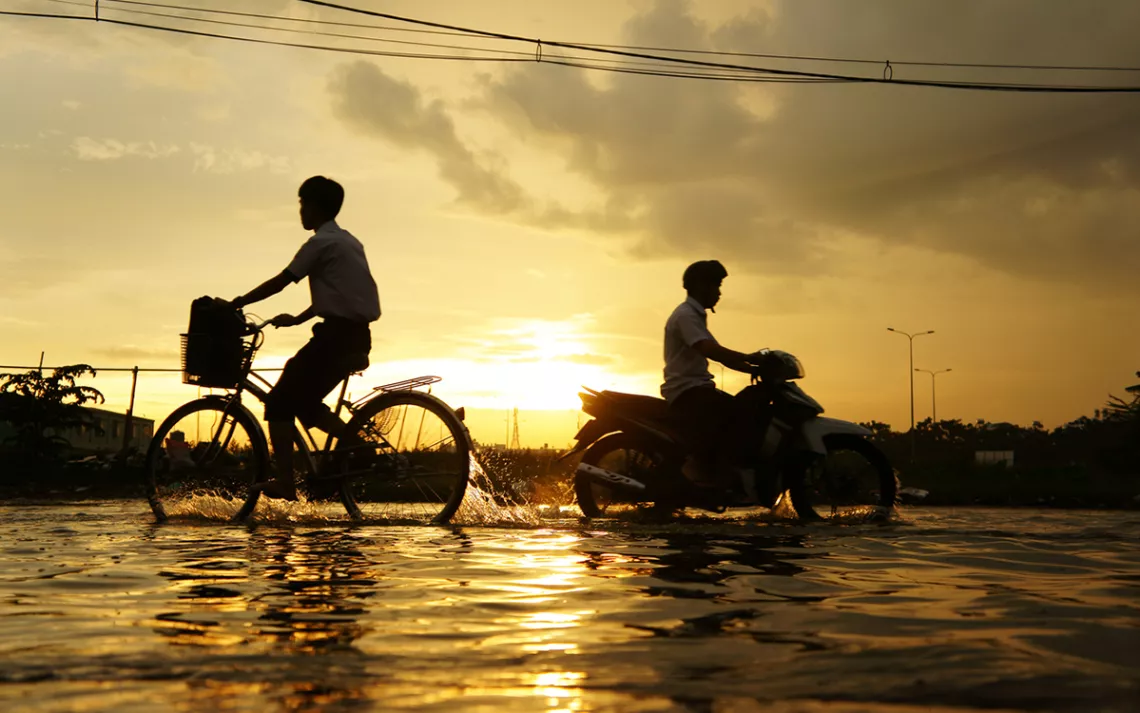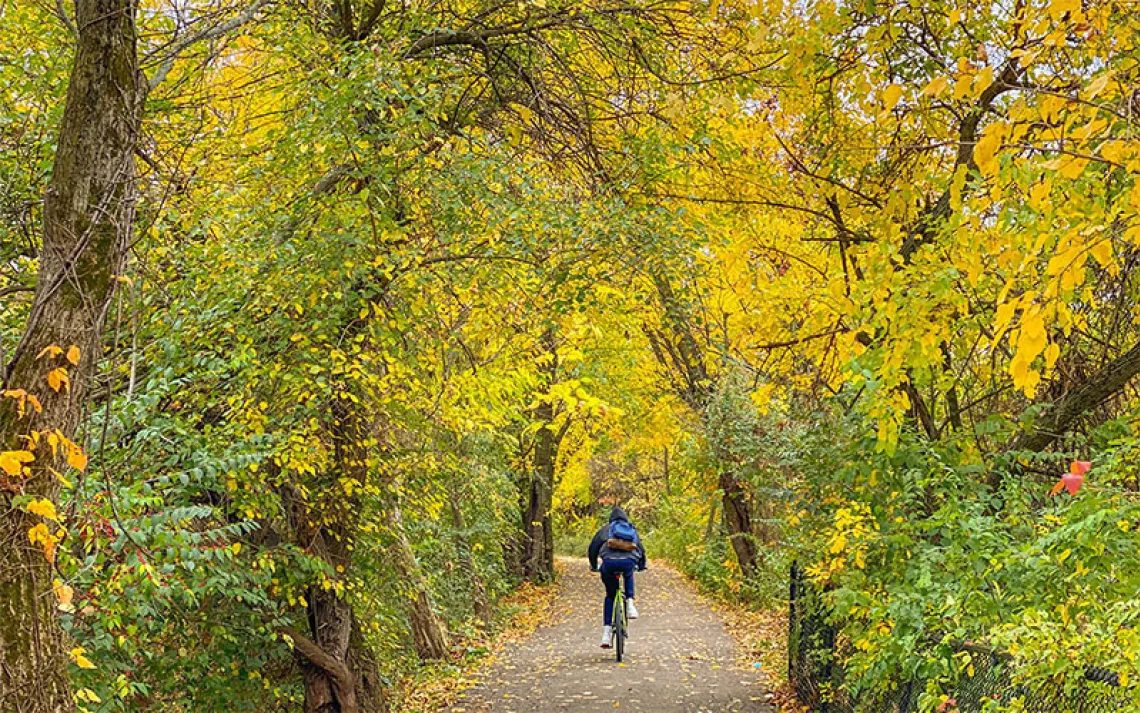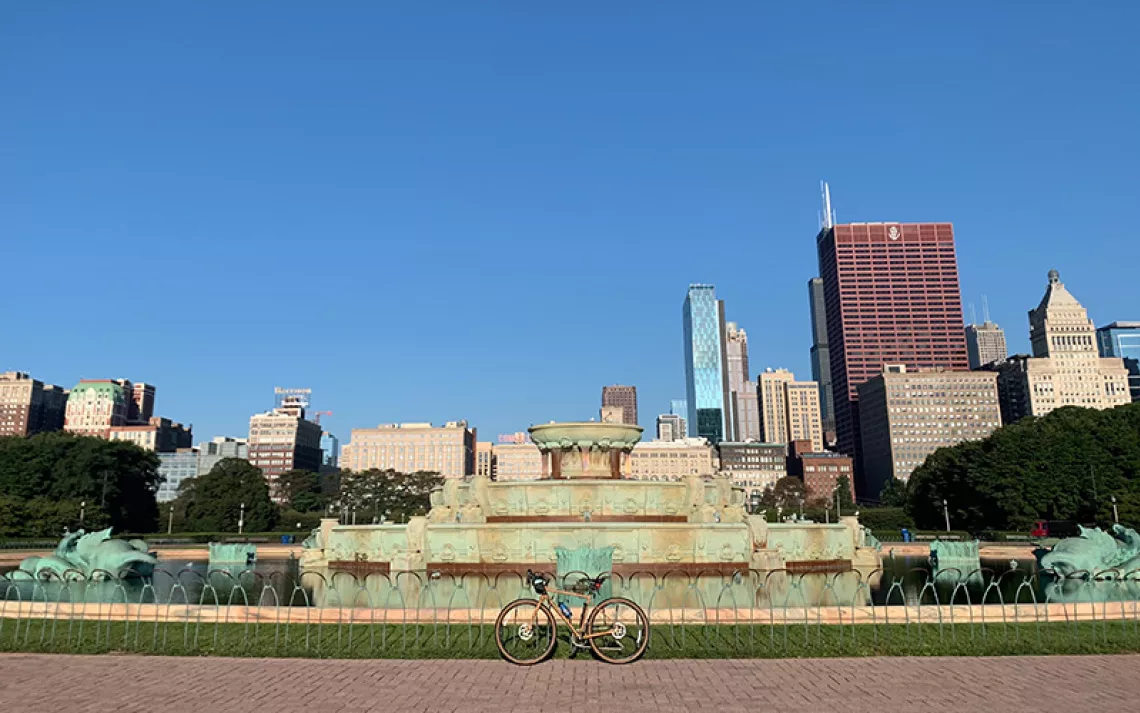No More Soggy Britches
Biking in the rain doesn't have to be a drag. Here's why.

Photo by IStock | Xuan Huongho
AND SAM MURPHY
The season of rain and sleet (and snow) is upon us. That doesn’t mean you have to stop biking. When done right, winter biking is a great way to stay active, combat the blahs, and justify the drinking of infinite hot chocolates. You just need to be prepared. I’ve spent over a decade biking in all seasons, including the wet, miserable ones. Sam Murphy, Sierra's photo editor, has done the same, with kids.
Here’s what we’ve learned:
Bike maintenance is different during the winter onslaught.
Most bikes work as well in the rain as they do in the sun, but rain will gunk up your bike’s chain, crankset, and derailleur—a.k.a, the super critical parts that allow your bike to actually function. If you live in a place where there’s snow, you are probably dealing with the added bonus of rock salt. So consider that maybe your super-fancy road bike might not be the ideal rain bike and that investing in a commuter, mountain, cargo, or touring bike could cost you less in repairs down the line. I’m a fan of touring bikes because they’re so easy to repair.
A good time to have a tune-up is before and after the worst of the winter weather gets going. This is also a great time to put on fenders (avoid the plastic kind) for tires. Get them at the beginning of the season and take them off at the end (if you live in an area with unpredictable rainfall, you may want to just keep these on full-time). If you’re a fan of slick tires (they are very speedy in dry weather), you’re really going to want rain or snow tires in the winter.
Rain tires are thicker than standard tires and help track the water like a river—make sure when they get installed that they are facing in the right direction. Sam approves of getting the thickest rain tires that the frame will allow onto the bike. I have a set of Continental Tour Ride tires that I use on my bike year-round. If you have older steel rims, be aware that they’re more slippery in the rain. It is important during this time to triple-check that your brakes are in good shape and working perfectly. Sam recommends disc brakes for biking in inclement weather; I’ve gotten by (so far) without them.
In the winter, you will have to grease your chain more. Some people wipe off the road gunk with a towel after every ride and reapply lubrication then. Others just do it at the end or beginning of each week. If you live in an area that applies road salt to streets, it’s a good idea to wash down your whole bike after you ride home at the end of the day. Now is also the time to turn all of your busted clothes and dish towels into rags, so that you have a nice pile of them near wherever you store your bike, so you can wipe it down (especially the moving parts) when you bring it home after a rainstorm.
Winter is also the perfect time to invest in a brighter bike light so everyone can see you even on the darkest and rainiest of days. As someone who has had a lot of bike lights stolen over the years, I always try to detach my headlight and store it in my jacket pocket, and have a spare stashed away somewhere in my pannier.
Having the right gear makes a huge difference.
The brighter and more reflective your gear is, the better. Once you have experienced good rain pants and jackets, you will never go back. Cheap ones make you arrive sweaty and are not worth it. Look for armpit zippers; pit zippers are your friend. Same with the rain paints with zippers that go all the way down the legs so that they’re easy to step out of. Good rain gear will last you a long time; you may need to re-treat it for maximal waterproofness. Sam also recommends rainproof boot covers and the kind of bike gloves that have a tiny squeegee on your thumb so you can wipe off your glasses.
Because you’re going to need a place to stash your wet gear (or a place to stash the dry clothes you’ve packed), you may need a bigger bike bag than you’re used to. I am a huge fan of Ortlieb roll-top bike panniers. Your fancy bike friends with their fancy commuter bike bags might judge you, but you know what? These are functionally the most indestructible panniers out there. Avoid the "bike shopper" version with the weird ziplock top—it lets in rain, breaks before the rest of the bag does, and you lose valuable stuffing capacity. Their waterproofness works both ways: You can take them to the fish market and fill them with crushed ice and oysters for somebody’s birthday party, no problem. If you have a favorite bag or backpack that isn’t waterproof, there are also backpacking rain covers you can get to deploy during times of heavy rainfall. Sam also reports that Dutch-style cargo bikes (the ones with the giant box in the front) stay surprisingly dry in the rain if you keep them covered.
Sam is also a fan of dry bags. Get one and pack it with a hand towel, a pair of socks (and shoes, if you need to wear nice ones at your destination) as well as any hair products or makeup you might be using when you clean off at the end of the ride. Biking in the rain can be messy, so don’t even bother trying to apply eye makeup before you arrive. Double-bag important things like phones and laptops.
Sam is rhapsodic about the Tuffo Muddy Buddy, a lightweight rain suit for kids. If you have a young child who likes to kick off their shoes, you can pack the shoes in your panniers and just duct-tape their feet. If you invest in nice raingear for your kids, Sam advises keeping it with you after you drop them off at school; get a cheaper raincoat that they can store at school so you won’t feel bitter if your kids lose the good stuff (or if someone else accidentally takes it home).
If you’re biking in cold weather, I am a fan of a) buying the most high-quality, dark-colored cashmere dress socks that you can afford and b) cutting the feet off when they wear out and wearing the sock legs as arm-warmers, so that those critical few inches of wrist that are exposed when you’re biking stay covered. You can buy arm-warmers at the store, but I have found that this method produces a much warmer and more resilient product.
If you need to be presentable at your destination, plan ahead.
Many offices (especially in cities where there are a lot of bike commuters) have showers on-site that commuters can use. Often, though, no one will bother to tell you about this perk when you get hired. So ask! You might be pleasantly surprised. If your office doesn't have accommodations for cyclists, organize your coworkers to push for a place to hang wet gear or membership to the nearest gym. Gym memberships are for more than just pumping iron: If you have a membership at a gym near where you work, it’s a great spot to clean up after you get soggy in the rainy months or sweaty during the hot ones.
The most important thing to remember: Don’t be afraid.
Biking in the cold (and rain) is not that hard. I started bike-commuting with a thrift-store raincoat on a cheap mountain bike that someone had abandoned in the bike room of my college dorm. I did fine. But it got easier the more I knew what I was doing, and once I got some better tools for the job, it got even easier. These days, I’ll actually pack a thermos of hot tea (Zojirushi SV-GWE50) and go bike in the rain for fun. It’s great—once you get to whatever park or scenic vista you’re heading to, you often have the whole place to yourself.
 The Magazine of The Sierra Club
The Magazine of The Sierra Club



